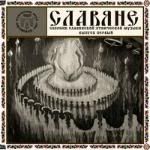
Artist: Glittertind (Norway)
Album Title: Landkjenning
Record Label: Napalm Records (Austria, US)
Released: 2009 (May)
Purchased From: The Omega Order
One can be forgiven for overlooking Glittertind's second full-length album (or third, if you count the demo Mellom Bakkar Og Berg), especially if that person has reached his or her saturation point with the genre of folk metal. The cover of a longship, and the sticker from Napalm Records that reads "Norwegian Folk Metal!," on the U.S. version at least, doesn't really inspire confidence that Glittertind is a band that will stand out from the pack of folk metal bands that have emerged in the wake of the genre's explosive popularity in the metal underground. However, this two-man project (which was a one-man project for the first several years of its existence) is no "Johnny-come-lately" folk metal band, nor is it typical with regards to its sound. Glittertind contains just as much of a punk and rock sound as it does metal, though it is far closer to "folk metal" than the preceding full-length, 2003's Evige Asatro (fortunately re-issued by Napalm Records to coincide with the release of Landkjenning), which had a much stronger punk sound. I'm not a fan of punk music, but Evige Asatro is a pretty good listen, though it's not something I will likely find myself listening to a lot.
However, Landkjenning is a very good and unique album, which is relatively mellow and accessible while also being authentic and thoughtful with regards to history, Norse paganism, and folk music. Thematically, the jumping off point here seems to be the story of Olav Tryggvason, the Norwegian king who is credited with/blamed for bringing Christianity to his native land in the late 10th century. According to the liner notes, Glittertind's goal with Landkjenning is to present two different viewpoints as to the Christianization of Norway. To present the side that looks at the Christianization as good, Glittertind has taken some of their lyrics from the Norwegian poet Bjørnstjerne Bjørnson, while the other side comes mostly from Glittertind's own perspective of history. This is not really a concept album, as there are songs about other topics, like the relationship of man and nature, the brotherhood of warriors, and the importance of living each day to its fullest. However, the beginning of Landkjenning deals with the return of Olav Tryggvason to Norway after his conversion, while the album ends with Olav's death in a battle at sea, followed by a somber but beautiful Norwegian traditional song, played on organ and Harding fiddle.
The musical style of the album varies from song to song. The tracks that speak of Olav Tryggvason in a positive light ("Landkjenning" and "Brede seil over Nordsjø gårhave") have an almost "sacred" quality about them, with layers of vocals resembling religious choral music. A few of the songs ("Nordafjells," "Varder i brann," and "Longships and Mead") are more upbeat, folk metal songs. "Longships and Mead" is the only English-language song on the album, and it has a rollicking sound that is bound to be a crowd-pleaser amongst fans of happy-sounding folk metal. There are a few punk-inspired songs ("Glittertind" and "Jeg snører min sekk"), and then a couple of slower, ballad-like tracks ("Går min eigen veg" and "Mot myrke vetteren"). The former of these ballads is especially beautiful, with excellent background vocals and flute.
Along with the guitars, bass, drums, and keyboards, Landkjenning contains Harding fiddle (a violin native to Norway), flute, accordion, and cello, as well as organ. Production is very high-quality, and everything from the instruments to the vocals are well-performed. Incidentally, it is worth mentioning that all the vocals on Landkjenning are sung, and sung rather well, in fact. Founding member Torbjørn Sandvik made a great decision to bring Geirmund Simonsen on board, as Geirmund's presence seems to have added much to the Glittertind sound.
From beginning to end, Landkjenning is an album that is worth your attention. It has a unique and engaging sound that I can't adequately compare to anything else out there. At times it reminds me of Týr, sometimes Lumsk, sometimes Vintersorg or early Ulver. It's pretty mellow, overall, for a metal album, and possibly strays too far to satisfy some fans. But I've enjoyed it quite a bit, and it's an album I continue to listen to on a regular basis several months after its release. Quite frankly, I'm a little surprised that this album hasn't gained more attention than it has, but I haven't seen it promoted as much as other pagan/folk metal bands on Napalm Records. Perhaps it is because Glittertind is primarily a studio band, though they are preparing to play some live shows. Regardless, if you're a fan of the genre and are looking for something unique, thoughtful, and oft-times beautiful, you should give Landkjenning a try.

